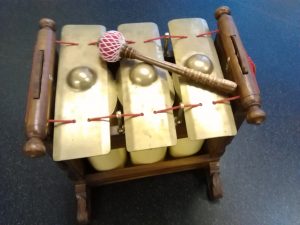Year 2
Autumn Week 7
45 minutes
The Slentho
We start the lesson with the whole class seated on the floor in absolute silence. I gently hum E-G-EE-G. The class hum back and one or two hazard an attempt at singing it with their newly learned pitch names. I remind them of their ‘musical pencils’.
We did quite a lot of work towards the end of Year 1 showing the pitch with pretend ‘musical pencils’.
Being a remarkably focused group this particular Year 2 class are largely showing me, correctly, that the melody begins with a lower pitch. Nonetheless I ask “Did it begin with a lower or higher pitch?” to encourage a few. Having established that we are singing a little phrase that begins with a lower pitch it is a small step to establish that it must start with ‘mi’ and not ‘so’. It’s my way of slowing things down; the children in the class do not have an equal level of understanding or skill. I sing ‘Hello Everyone’ to the same tune and the class respond with hand signs and the pitch names.
I clap the rhythm of a rhyme that the children know very well:
Buster, Buster climb a tree,
Buster Buster slap your knee,
Buster, Buster blow a kiss,
Buster, Buster do not miss
We play the Radio Game with individual volunteers leading. The leader must say ‘Off we go’ in a rhythmic way and then indicate to the class (with an opened or closed hand) whether the radio is on or off. Again the class must watch closely, as musicians, and say the rhyme either with a speaking voice or in a Thinking Voice (i.e. in their head and not out loud). We’ve played it before and the class have done this a few times since the last music lesson a week ago. After a few rounds I ask the class how many phrases there are in this little rhyme. Naturally enough, nearly everyone realises there are four phrases, even if they have never heard the word ‘phrase’ in this context before.
“What song has the same rhythm as that rhyme?”
I clap it again and by the end of the clapped rhythm the whole class is singing the song. They’ve already been on their feet doing the actions to Buster Buster but we get up again and, in pairs, clap and pat (with a partner) to the beat. This is extended to having mini-circles of four (two pairs). This is the sort of thing that is simply fun.

We all come back together and sing the song again accompanied by the beautiful ‘slentho’ (this bass Gamelan instrument is tuned to I – IV – V). I play A/D to the beat. It sounds sweet and many are drawn to the instrument, really staring in total fascination. It’s time to do some work on the difference between the beat and the rhythm. It’s a distinction that lots of adults do not appreciate. Volunteers come to the front to play the beat on hand drums, three at a time, and the rhythm on claves, again three at a time. With the whole class singing and these instruments, as well as the slentho, it’s starting to sound multi-layered and interesting.
We do more work on the difference between beat and rhythm singing the song Copy Cat. Some volunteers tap 8 heartbeats drawn on the board to the beat and then to the rhythm. To tap the rhythm onto 8 heartbeats is difficult and only two of the five volunteers manage to do it.
Throughout the lesson I have been making notes here and there, scribbling in a large blue note book. I hope the children don’t find this too distracting or, even worse, think that they are being monitored in some way. In fact, of course they realise this. When do young children at school recognise that they are being continually assessed, monitored and grouped by the adults around them? Does it matter that they know? Whatever the answer to these questions I do have a useful record of general musical ability that is growing all the time. I hope that this will be of some use to their class teachers. Perhaps it can even help to broaden the school’s understanding of the intelligence of these children. I hope so.
I think this lesson needed a section with a longer song in it, something with two or three verses and a wider variety of pitches. This lesson did have lively, active elements, including some children (not all) playing instruments, but it felt a little too contained. Maybe this is how it feels to me because this particular class is an unusually calm and collected one?